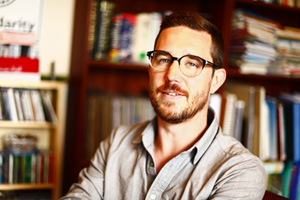What I Want To Tell Goes Like This: Matthew Hooton in Conversation with Matt Rader

As a follow-up to Matt Rader's Founders Award interview with Rachel Lallouz, former fiction board member Matthew Hooton talks with Rader about his first short story collection, What I Want To Tell Goes Like This, published in autumn 2014 by Nightwood Editions.
Is there anything about the book's content or creation that might not be immediately apparent? Any secrets you'd like to let us in on?
The collection alternates between contemporary and historical stories set in the Comox Valley on Vancouver Island (or else in transit on way to the Comox Valley). One thing that might not be immediately apparent is that several stories share a specific location in the valley. For example, the first story, "The Laurel Whalen," is set on a beach where a ragtag fleet of decommissioned commercial ships act as a breakwater. In the following story, "The Children of the Great Strike, Vancouver Island 1912-14," that same beach serves as the setting for a strikers camp where much of the narrative takes place.
Similarly, "Alone Mountain" recounts the minutes and days after the shooting death of the labour activist, Albert "Ginger" Goodwin, at the foot of Alone Mountain on Comox Lake, while the brief story, "At the Lake," which was first published in The Malahat Review, recounts a troubling sexual encounter in the same place, 100 years later.
These pairings also share thematic and formal concerns that likewise may not be immediately apparent, some I’m just learning myself as I have the opportunity to talk more about the collection. For example, I somehow only just now realized that friendship and social solidarity are major thematic concerns in both "The Laurel Whalen" and "The Children of the Great Strike."
What books or stories served as models? What other influences do you see in the book's pages? Music, visual art, film, people?
There are stories and paragraphs where I feel the very specific influence of certain books or writers. The opening paragraph of "The Laurel Whalen" is heavily indebted in terms of tone and narrative procedure to Richard Ford’s collection Rock Springs. This was something I was only reminded of very recently when I heard Ford read from that collection at the Cork International Short Story Festival in Cork City, Ireland.
As I’ve spoken with The Malahat Review about before, the final story, "All This Was a Long Time Ago," is directly influenced by Raymond Carver and James Joyce and indirectly by Anton Chekhov. The title is taken from T. S. Eliot, but Timothy Findley uses the same phrase to begin the second chapter of The Wars, a book about the years directly following those in which my historical stories are set. Findley uses a number of strategies that were influential including a layering of narrative apparatuses that become clear or opaque depending on how he’s handling the conceit of our "access" to history: Findley’s researcher character, who is positioned at least one remove from the main narrative, is plagued by gaps in the historical record and the novel itself echoes those gaps as if Findley’s imagination couldn’t overcome certain blank spaces. The lesson for me was that the gaps in history, the impenetrable mystery of the past, can itself be part of the story.
Another book that was influential, but whose influence I had forgotten, is Winter Count by Barry Lopez. Those stories often use a narrative procedure that mimics nonfiction or reportage. I used a similar strategy in a number of the historical stories.
Mary Gaitskill’s Don’t Cry was also a major influence in how I approached some of the blind spots in the collection. I feel her presence most strongly (though it may not be an obvious presence even for readers of Gaitskill) in the story "The First Women’s Battalion of Death." I came to Don’t Cry in the final stages of this manuscript and it changed everything for me. I feel like I will have to answer to that collection for everything I write after, but that’s for another conversation.
I have a record called Come All You Coal Miners recorded in the Appalachians in 1972. This record is the tonal and melodic midwife of the story "The Children of the Great Strike." The songs are haunting. Here are some of the titles: "Black Lung Blues," "Don’t You Want to Go," "Cold Blooded Murder," "Both Lungs Is Broke Down," "30 Inch Coal," "Dreadful Memories," "That 25¢," "Mannington Mine Disaster."
Can you tell us about some of the stories that aren't in the collection, and why they were cut?
I worked on this manuscript for over 10 years. In that time, it changed so much that only one story survives from the original draft collection. For most of those 10 years I had no plan. Or the plan was developed one story at a time and largely intuitively. It was only earlier this year that the ultimate arrangement presented itself. When it did, it was if it had always been there.
A number of stories that I published in journals didn’t make it into the final draft including "The Lonesome Death of Joseph Fey," a story that was selected for the Journey Prize Anthology. Similarly stories that appeared in Riddle Fence, Grain, and Prism International were cut or never included. Mostly, these stories were not included because I felt--and my publisher, Silas White, agreed--that other stories covered similar territory in ways that were more effective in the context of the collection as a whole.
For example, one of the last cuts was a story called "Arrangements." This is a story about a man in his nineties who calls his grandson when the man’s wife is taken in to hospital for what is certainly the last time. "Arrangements" is about end of life and the way established relationships both persist and breakdown in that context.
Silas and I liked the story--though we had slightly different reasons for liking it--but we each felt that a story like "Bearing the Body," which appeared originally in The New Quarterly, and tells the story of a son tending and attending to his father’s death, did similar thematic work and had certain narrative elements (for example, the father in "Bearing in the Body" is an Iron Worker) that fit more resonantly within the collection as a whole.
Can you tell us how it feels to hold the collection in your hands? What does it mean to you to have your work published as a paper book, an artifact?
Great. A relief. Bewildering. To some degree, I think things we can’t find online, that exist "offline," can begin to appear to not exist at all, as if they are imprisoned by their physical dimensions, unable to be glimpsed from screens around the world (though still mostly in North America and Europe if reports are to be believed). It’s as if the digital representation is itself the real thing, the only true thing. I’m sure Plato and Slavoj Žižek would have something to say about this in their cave warming their hands around the fire. In my life, however, I find it impossible to remember that digital books exist. Even the digital books I "own" or "possess" I can never remember. My memories are bound up in the object. Maybe this is the materialist in me. Or me in the material.

Matthew Hooton
* * * * * * * *









